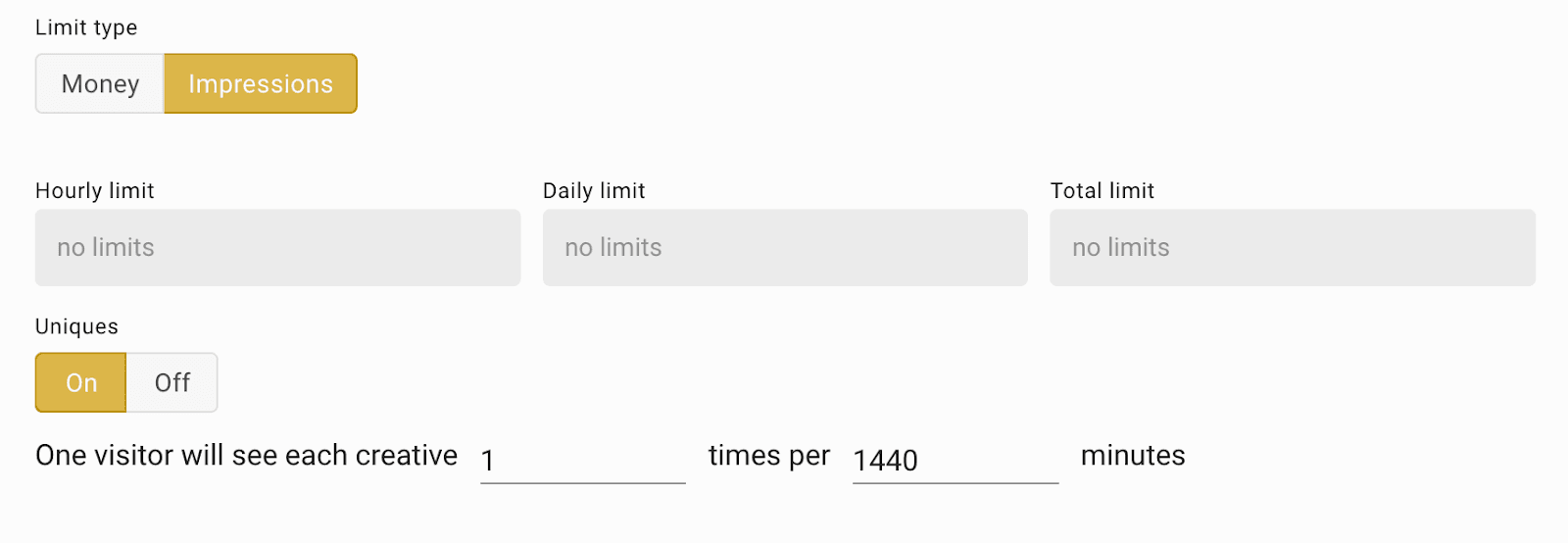Targeting is a crucial factor in achieving success in advertising campaigns, and frequency capping plays a significant role in optimizing campaign performance. Discover how you can save costs and boost your return on investment (ROI) by implementing an effective frequency cap for your ad campaign.
It helps advertisers control the frequency with which their ads are displayed to users, preventing ad fatigue and improving the overall user experience. Let's take a closer look at frequency capping and its benefits in digital advertising.
In digital advertising, frequency capping is a tactic used by advertisers to limit the number of times an ad is shown to the same user in a given time frame. This time frame could be a day, a week, or a month, depending on the campaign objectives and targeting strategy.
Frequency capping is typically implemented at the campaign level and can be applied across various advertising channels, such as display ads, video ads, and social media ads.
Why is Frequency Capping Important?
Frequency capping is crucial for several reasons:
1) Ad Fatigue Prevention: Showing the same ad to a user too many times can lead to ad fatigue, where users become annoyed or disinterested in seeing the same ad repeatedly. This can negatively impact ad performance and result in lower engagement, click-through rates (CTR), and conversion rates. Frequency capping helps prevent ad fatigue by limiting the number of times an ad is shown to the same user, ensuring that the ad remains fresh and relevant.
2) Improved User Experience: Digital advertising should provide a positive user experience. Bombarding users with the same ad repeatedly can be intrusive and annoying, leading to a poor user experience. Frequency capping helps create a better user experience by preventing overexposure to ads and ensuring that users are not overwhelmed with repetitive ads.
3) Efficient Ad Spending: Limiting the frequency of ad impressions can help advertisers optimize their ad spend. By avoiding excessive ad repetition, advertisers can ensure that their ad budget is allocated effectively, and their ads are shown to a wider audience. This can result in better overall campaign performance and improved return on investment (ROI).
4) Better Targeting: Frequency capping can also help advertisers fine-tune their targeting strategy. By setting limits on ad frequency, advertisers can ensure that their ads are shown to a diverse audience, rather than repeatedly targeting the same users. This can help expand the reach of the campaign and expose the ad to a wider range of potential customers.
5) Ad Campaign Optimization: Frequency capping allows advertisers to analyze ad performance data and optimize their campaigns in real-time. By monitoring the frequency of ad impressions, advertisers can identify patterns and adjust their frequency capping settings to align with their campaign objectives. This flexibility enables advertisers to fine-tune their campaigns and achieve better results.
How to set up frequency capping?
To set up frequency capping for your ad campaign, navigate to the relevant section during the campaign creation process. Here, you can specify the desired number of times and duration in minutes that a visitor will see your ad.

It is generally recommended to aim for an optimal ad frequency of 2 exposures throughout the duration of the campaign. Most advertisers set a frequency cap of 1440 minutes (equivalent to 2 days). Too few ad displays may result in reduced conversion rates and reach, while setting the ad display frequency too high can result in unnecessary expenditure.
For newly-entered brands in the market, it may be beneficial to increase the frequency cap to 4 times per day initially. This approach can help maximize brand exposure, while ensuring that viewers do not become fatigued or disinterested.
Frequency capping is a crucial tactic in digital advertising that helps advertisers control the number of times an ad is shown to users within a specific time period. It prevents ad fatigue, improves user experience, optimizes ad spend, and allows for better campaign targeting and optimization. By implementing frequency capping effectively, advertisers can improve the overall performance of their campaigns and create a positive experience for their target audience.
***EDITED BY ADMIN***
It helps advertisers control the frequency with which their ads are displayed to users, preventing ad fatigue and improving the overall user experience. Let's take a closer look at frequency capping and its benefits in digital advertising.
In digital advertising, frequency capping is a tactic used by advertisers to limit the number of times an ad is shown to the same user in a given time frame. This time frame could be a day, a week, or a month, depending on the campaign objectives and targeting strategy.
Frequency capping is typically implemented at the campaign level and can be applied across various advertising channels, such as display ads, video ads, and social media ads.
Why is Frequency Capping Important?
Frequency capping is crucial for several reasons:
1) Ad Fatigue Prevention: Showing the same ad to a user too many times can lead to ad fatigue, where users become annoyed or disinterested in seeing the same ad repeatedly. This can negatively impact ad performance and result in lower engagement, click-through rates (CTR), and conversion rates. Frequency capping helps prevent ad fatigue by limiting the number of times an ad is shown to the same user, ensuring that the ad remains fresh and relevant.
2) Improved User Experience: Digital advertising should provide a positive user experience. Bombarding users with the same ad repeatedly can be intrusive and annoying, leading to a poor user experience. Frequency capping helps create a better user experience by preventing overexposure to ads and ensuring that users are not overwhelmed with repetitive ads.
3) Efficient Ad Spending: Limiting the frequency of ad impressions can help advertisers optimize their ad spend. By avoiding excessive ad repetition, advertisers can ensure that their ad budget is allocated effectively, and their ads are shown to a wider audience. This can result in better overall campaign performance and improved return on investment (ROI).
4) Better Targeting: Frequency capping can also help advertisers fine-tune their targeting strategy. By setting limits on ad frequency, advertisers can ensure that their ads are shown to a diverse audience, rather than repeatedly targeting the same users. This can help expand the reach of the campaign and expose the ad to a wider range of potential customers.
5) Ad Campaign Optimization: Frequency capping allows advertisers to analyze ad performance data and optimize their campaigns in real-time. By monitoring the frequency of ad impressions, advertisers can identify patterns and adjust their frequency capping settings to align with their campaign objectives. This flexibility enables advertisers to fine-tune their campaigns and achieve better results.
How to set up frequency capping?
To set up frequency capping for your ad campaign, navigate to the relevant section during the campaign creation process. Here, you can specify the desired number of times and duration in minutes that a visitor will see your ad.

It is generally recommended to aim for an optimal ad frequency of 2 exposures throughout the duration of the campaign. Most advertisers set a frequency cap of 1440 minutes (equivalent to 2 days). Too few ad displays may result in reduced conversion rates and reach, while setting the ad display frequency too high can result in unnecessary expenditure.
For newly-entered brands in the market, it may be beneficial to increase the frequency cap to 4 times per day initially. This approach can help maximize brand exposure, while ensuring that viewers do not become fatigued or disinterested.
Frequency capping is a crucial tactic in digital advertising that helps advertisers control the number of times an ad is shown to users within a specific time period. It prevents ad fatigue, improves user experience, optimizes ad spend, and allows for better campaign targeting and optimization. By implementing frequency capping effectively, advertisers can improve the overall performance of their campaigns and create a positive experience for their target audience.
***EDITED BY ADMIN***
Last edited by a moderator:







